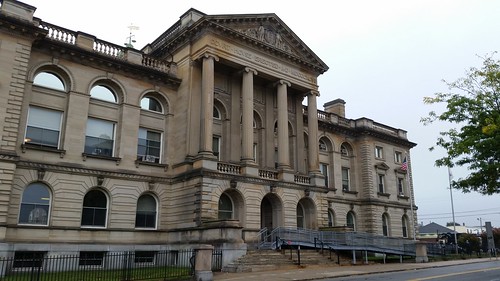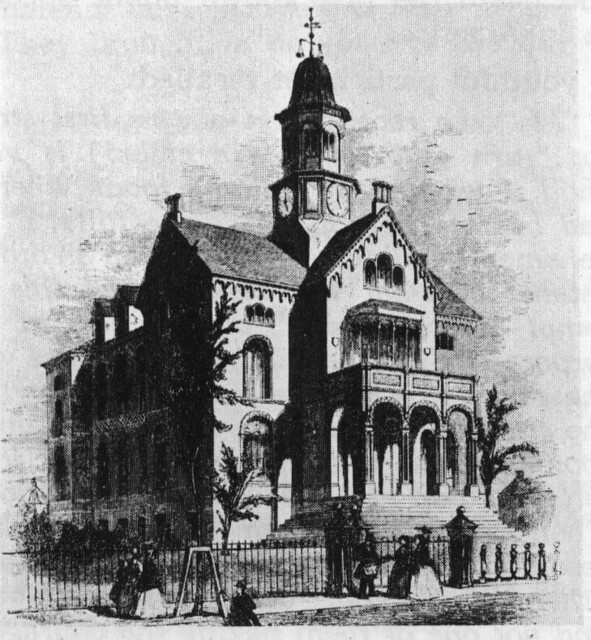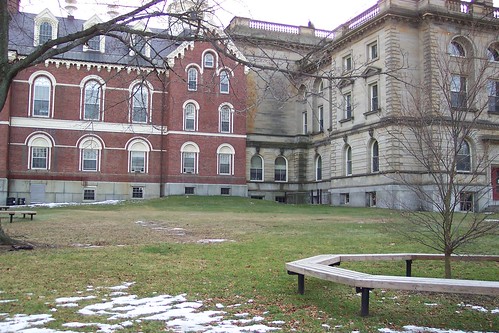Lowell Places: Superior Courthouse

Middlesex Superior Courthouse, 360 Gorham Street, Lowell
“Lowell Places” is a new category of blog posts that will appear from time-to-time to tell the story of buildings, parks, bridges and other structures of historical interest in Lowell, Massachusetts.
Incorporated as a town in 1826 and a city in 1836, the rapid growth of Lowell brought an increase in legal matters originating in the city. To obtain space for a new courthouse, Middlesex County purchased a 106,380 square foot parcel along Gorham Street on Chapel Hill from James Dana of Charlestown, and Thomas Nesmith and Andrew Wheelock of Lowell on May 4, 1847. The purchase price was $11,032 and the lot ran 550 feet north along Gorham Street from the intersection with Elm, then 150 feet easterly to Linden Street; then 466 feet along Linden to Elm; then 280 feet along Elm to Gorham.

Lowell Superior Court in 1850
Designed by Amni Burnham Young, whose previous work included Boston’s Custom House and additions to courthouses in Worcester and Cambridge, the was completed in 1850. The local media called the Romanesque Revival-style building “the finest in the state” and “one of the handsomest courthouses in the country.”
Changes came quickly. In 1855, the legislature created the Middlesex Northern District Registry of Deeds to maintain custody of land records for the communities of Billerica, Carlisle, Chelmsford, Dracut, Dunstable, Lowell, Tewksbury, Tyngsborough, Westford and Wilmington, with the registry occupying quarters on the first floor of the courthouse, where it remains today.
On September 4, 1860, Middlesex County carved from the courthouse lot a $16,439 square foot parcel north of the contemplated street from Gorham to Linden (which street is now called Hobson Street) and conveyed it to the Trustees of Donations to the Protestant Episcopal Church on the condition that it “be always used as a Protestant Episcopal Church.” St. John’s Episcopal Church was soon constructed on this new parcel. It remains in use as a church today.
As Lowell continued to grow, so did the amount of litigation that arose in the region. In 1894, the Middlesex County Commissioners voted to expand the courthouse. Rather than add on to the rear of the existing building which sat right along Gorham Street, the Commissioners instead chose to move the 1850 building 60 feet backward and build the addition – in the form of a completely new building – in the vacated space.

Superior Courthouse from Hobson Street, showing the original 1850 building (left) and the 1898 addition (right)
To move the three-story red brick building, workers dug underneath and propped it up on heavy wooden beams supported by 800 jacks. Other jacks, placed perpendicular to the side of the excavation, pushed the entire structure backwards. The building moved one inch each hour. According to a contemporary newspaper, “. . . so little is the movement perceptible that work goes on in the registry of deeds office just the same as usual. The project took four years to complete with the new building being formally dedicated on September 12, 1898.
From the outside, little appears to have changed in the 120 years since the opening of the “new” Superior Courthouse. One exception came in 2011 when an elevator was added to make the building more accessible. An elevator shaft was constructed outside the south wall of the 1850 building. The shaft’s brick walls, windows and molding match almost exactly their much older counterparts on that side of the building.
Inside the building, the main walls, hallways and stairs are much like they were a century ago, however, more recent updates to heat, electricity and plumbing make the building habitable by twenty-first century standards.
A year from now, all of the occupants of the Superior Courthouse will move to the new Lowell Judicial Center and the search will begin for a new use of this grand old building.